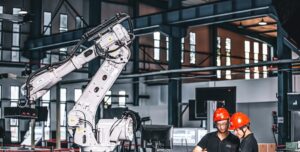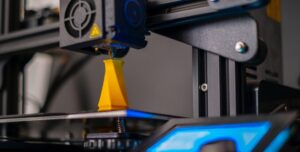FROM INDUSTRY 4.0 TO INDUSTRY 5.0
As we tread the path of technological evolution, automation emerges as a prominent protagonist, driving the epochal shift from Industry 4.0 to Industry 5.0 in manufacturing. Automation is redefining the fabric of manufacturing, making it more efficient, safer, and hyper-customized.

INDUSTRY 4.0: THE DAWN OF AUTOMATION IN MANUFACTURING
The journey of automation in manufacturing began with Industry 4.0, characterized by the integration of automation and data exchange. The prolific use of data and connected devices, advanced analytics, machine learning, human-machine interaction, and innovative engineering technologies marked this industrial revolution.
The hallmark of Industry 4.0 was the concept of the smart factory, where cyber-physical systems monitor physical processes, create a virtual copy of the physical world, make decentralized decisions, and operate independently. The seamless connection between the physical and digital worlds enhanced productivity and efficiency, laying a robust foundation for the next phase of industrial evolution.
INDUSTRY 5.0: THE EVOLUTION OF AUTOMATION
Industry 5.0 takes the essence of Industry 4.0 further, emphasizing not just efficiency and productivity, but also the socio-economic contribution of the industry. This industrial revolution underscores the importance of hyper-personalization and collaboration between humans and robots, taking automation to unprecedented heights.
HYPER-PERSONALIZATION IN MANUFACTURING
With Industry 5.0, the manufacturing sector is stepping into the era of mass customization. Advanced technologies such as 3D printing and computer-aided design (CAD) are playing a pivotal role in enabling bespoke manufacturing at scale.
Manufacturers are leveraging big data analytics, artificial intelligence (AI), and machine learning to process massive volumes of data, understand individual preferences, and deliver customized products. This data-driven approach facilitates the creation of personalized product configurations, packaging, branding, and pricing.
Moreover, data is crucial for enabling real-time monitoring of production processes. With digital systems, databases, and Internet of Things (IoT) devices, manufacturers can track the progress of personalized products through the production line, ensuring accuracy and efficiency.

HUMAN-ROBOT COLLABORATION
While Industry 4.0 focuses on quality, flow, and data collection, Industry 5.0 highlights the collaboration between highly skilled people and robots. This has led to the advent of collaborative robots, or cobots, on factory floors.
Cobots employ various sensors to navigate, perceive environmental changes, and make accurate judgments in complex situations. From torque sensors that offer a sense of ‘touch’ to tactile sensors that distinguish between inanimate objects and humans, these robots are equipped with advanced technology to work safely alongside humans.
One of the core technologies driving these Industry 5.0 trends is custom integrated circuits (IC). ICs interface directly with the sensor element, enabling efficient and accurate signal acquisition. They provide sensor-specific conditioning, amplification, filtering, and digitization, simplifying the sensor system design and enhancing overall performance.

FUTURE OF AUTOMATION: THE IMPACT OF ROBOTICS
The future of automation in manufacturing is strongly influenced by the advent of robotics. Over the past decade, robotics has revolutionized various sectors, including manufacturing. The rate of adoption is accelerating, fueled by the availability of new materials and technological advancements.
Protolabs’ study revealed that nearly one-third of industry players believe new materials will significantly impact how robotics is used within manufacturing in the next five years. For instance, flexible soft grippers that can handle delicate items could lead to several applications in the agricultural and food industries.
However, while new materials offer tremendous opportunities for innovation, it’s essential to consider their availability, as supply chain issues can hinder development cycles. This highlights the need for a robust material supply chain, which is considered a significant barrier to innovation by 27% of the survey respondents.
HARNESSING COLLABORATION FOR BETTER DESIGN AND PROTOTYPING
Amid these technological advancements, collaboration emerges as a crucial aspect of successful innovation. Manufacturers are increasingly collaborating with partners to make informed decisions about embracing innovation.
By collaborating with digital manufacturing partners, manufacturers can access fast, cost-effective options for design and prototyping, enabling them to test, iterate, and retest. Feedback from automated design analysis helps organizations refine their designs before producing any physical prototypes. This iterative design or Design for Manufacturing (DFM) approach is crucial for minimizing time and costs.
EMBRACING ONSITE TECHNOLOGY FOR IMPROVED HEALTH AND SAFETY
A critical aspect of automation is its potential to improve health and safety in manufacturing. Emergent technology like wearable devices, communication tools, and drones can help identify and mitigate risks, preventing accidents and ensuring a safer work environment.
Wearable technology can detect threats like hazardous gases, protecting workers’ health. Drones can be used to inspect accident sites from a safe distance, preventing risks associated with direct contact. Moreover, rugged mobile devices enhance onsite communication, enabling quick identification and reporting of potential hazards.
THE ROAD AHEAD: THE TRANSFORMATIVE POWER OF AUTOMATION
As automation continues to evolve, the manufacturing industry must tap into the expertise of the digital manufacturing supply chain to unlock the immense potential of automation. The rapid pace of technological advancements indicates that Industry 5.0 could arrive sooner than anticipated. Therefore, understanding impending trends and the electrical components central to their success is key to staying ahead of the curve.
While the journey of automation has just begun, its transformative potential is immense. As it continues to redefine the manufacturing landscape, the future beckons with promising prospects, marking the dawn of an exciting new era in the world of manufacturing.




